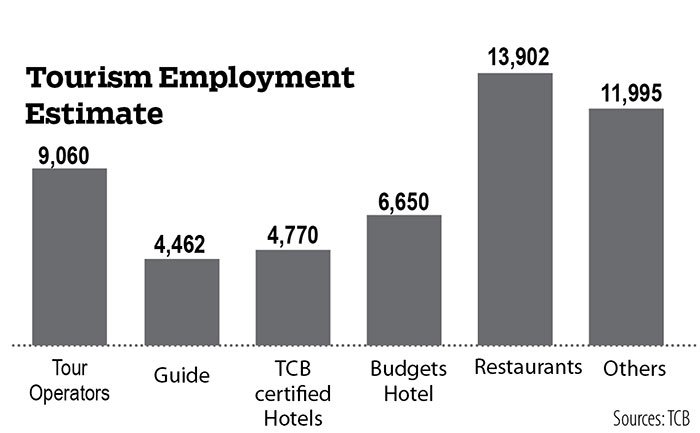MB Subba
It looked like the country was set to have one of the best years in tourism after the Lonely Planet in October 2019 recognised Bhutan as the number one travel destination for 2020. What happened is just the opposite.
Last year in the first quarter, from January to March, 12,786 tourists had visited Bhutan. The number dropped by almost half. Only 6,624 tourists visited Bhutan in the first quarter of this year.
From January 15 to March 16, about 1,960 tourists cancelled their visa to visit Bhutan.
The year 2019 saw a total of 315,599 tourists visit Bhutan, which is a 15.14 percent increase compared to 2018.
The impact of the Covid-19 pandemic is also expected to hit the country’s convertible currency reserve as the Tourism Council of Bhutan (TCB) forecasts that Bhutan is unlikely to see arrivals until the next year.

In the first quarter of this year, tourism generated a gross receipt of USD 10.14 million (M), according to TCB reports. Last year, tourism generated a total gross receipt of USD 88.63M from the MDPR paying (international tourists) arrivals, a 3.77 percentage change as compared to 2018.
As per the annual tourism revenue growth rate, the gross receipt from the MDPR paying arrivals was estimated to hit almost USD 92 million in 2020. This means that with the closure of tourism, the country will lose about USD 82M in convertible currency from tourism.
The government hopes that the country will receive more foreign assistance to make up for the loss of convertible currency from tourism.
An official from the prime minister’s office at a recent press briefing said that development partners had come forward to assure more assistance to help Bhutan cope with the situations created by the pandemic.
Officials from TCB recently presented the tourism situation report to the joint parliament committee on Covid-19 preparedness.
The TCB reported that the government has allocated a total of Nu 220.4M as the tourism stimulus package for training and gainful engagement of affected people from the sector.
According to TCB, a total of 2,512 people have confirmed their participation in various activities under the stimulus programme. If the number of candidates remains the same and all the allocated money is utilised, TCB will spend Nu 87,738 on each person on an average.
The amount allocated for engagement of affected people in infrastructure and product development is Nu 94.1 million. But only 62 people have confirmed their willingness to engage in infrastructure and product development.
A total of Nu 97 million has been allocated for the training and re-skilling programme, for which 1,412 have confirmed their participation. But the programme has been deferred due to social distance reasons.
According to TCB, travel will fundamentally change and the sector will not resume as it was before.
TCB estimates that the closure of tourism has affected the livelihoods of about 50,000 people in hotels, handicrafts, airlines and transport among other businesses.
The TCB hopes that arrivals will start from January next year. The TCB estimates that Bhutan in January next year will see 30 percent of the arrivals in January this year.
Thereafter, arrivals are estimated to increase by 10 percent monthly for the rest of the year, except for the peak months of March, April and September and October at 20 percent.
The joint parliamentary committee members acknowledged and appreciated that TCB’s efforts but felt that the current plans and progammes were not satisfactory.
The committee’s chair, Dorji Wangdi, said that some of the programmes being undertaken by TCB were not in keeping with the government’s standing statement of focusing on two things in tourism sector: skilling programmes and development of new tourist amenities.
He said that there was no regional distribution as all programmes were still concentrated in current top five tourist-rich dzongkhags.
“The current stimulus programmes are largely traditional and there are no innovative and long-term strategies and programmes. Expenses must be prudent and programmes sustainable,” he said.
He said that it was the right time to take the opportunity to focus on developing a standard operating procedure (SOP) for implementation of SDF as regional tourists would realistically be the first ones to step in.

